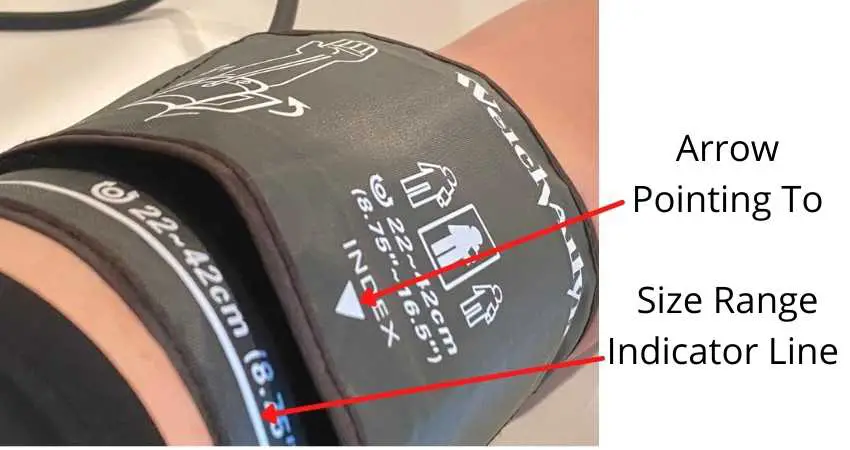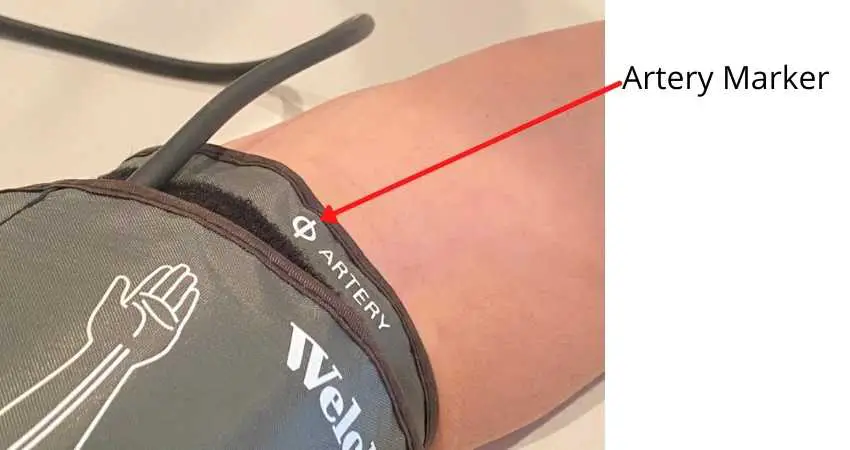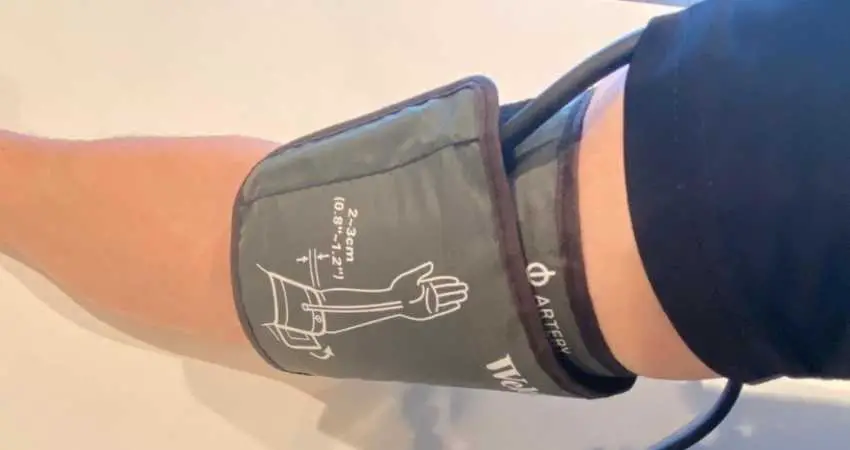The first experience with a home blood pressure monitor can be confusing. The cuff and how it gets positioned are what makes most people scratch their head. Reading the manual for your monitor is crucial for measurements. However, many people will ask, where does the arrow on a blood pressure cuff go?
If the arrow on a blood pressure cuff is an artery marker, it should be pointed down the arm to the brachial artery at the elbow joint. If the arrow is not an artery marker, it typically points towards the size range indicator line on the cuff.
The answer depends on what manufacturer cuff you have. You would think all cuffs would have the same arrow markings, but unfortunately they don’t. This blog post will go into complete detail on all of the popular scenarios and walk you through the steps with photos to guide you properly.
Disclaimer: Some links in this article are affiliate links which means I may earn a small commission at no extra cost to you. As an Amazon associate and eBay partner I earn from qualifying purchases.
BP Tip: Lower BP naturally by changing how you breathe? A device approved by the FDA and The American Heart Association guides your breathing a few minutes a day which has been proven to lower BP. You can check it out in the manufacturer’s website by clicking here.
When The Arrow On A BP Cuff Is An Artery Marker
On some blood pressure cuffs the arrow is meant to be an artery marker. When the arrow is an artery marker, it will point down towards the hand and should line up with the brachial artery in the elbow joint.
On the right or left arm, this would be more towards the inner part of your arm towards your torso ((Hypertension: Measurement of Blood Pressure in Humans: A Scientific Statement From the American Heart Association)).
On this style cuff, the majority of the cuffs will have the words artery or artery marker next to the arrow. Instead of an arrow some cuffs will use another symbol, like a circle with a line drawn through.

When The Arrow On A BP Cuff Is A Size Indicator Marker
On some blood pressure cuffs the arrow is not an artery marker and is meant to help indicate the cuff is properly sized. After securing the cuff and lining up the artery marker, the arrow should be pointing towards the size range indicator line on the cuff.

Typically the arrow will point towards the upper part of the cuff towards the shoulder. Most cuffs will have the size range indicator line on the opposite side of the cuff from the artery marker.
Depending on the manufacturer, the size indicator arrow may be labeled differently. The following are some of the more popular terms used:
- Index
- Fit Indicator
The size indicator line runs from left to right on the edge of the cuff. It is there to help make sure the cuff is the appropriate size for the upper arm. If the cuff is at the proper tightness and is the correct size for your arm, the arrow will point somewhere to the line.
On my home monitor, the Welch Allyn 1700 Series, the artery marker is a small circle with a line drawn through it1. There is an arrow on the other side pointing towards the size range line.
Every manufacturer may have a slightly different marker for the artery.

I have a detailed review of the Welch Allyn 1700 Series. If you want to check it out and see photos of it and the phone app, click here, Welch Allyn Home 1700 Series Blood Pressure Monitor Review.
When There Is No Arrow On The BP Cuff
On the Omron 10 Series monitor, the blood pressure cuff doesn’t have an arrow or an artery marker. Instead, they instruct you to line up the tubing on your left arm with your middle finger.
On the right arm the tube should run along the side of the elbow, along the bottom of your arm2.
Always refer to the instruction manual for your home monitor for instructions. If you don’t have the manual, you can always find it by visiting the manufacturers website. In addition, most companies have a support phone number you can call.
BP cuff arrow placement is one of 14 sections in my article about blood pressure cuffs. Learn more about BP cuffs, including how to apply them, errors made and sizes, here in the article, Blood Pressure Cuffs.
Why Does A Blood Pressure Cuff Have An Artery Marker?
When the artery marker is lined up with the brachial artery at the elbow, the cuff bladder is centered on the brachial artery ((John Hopkins Children Center: Blood Pressure Measurement Essentials)). This helps to ensure when the cuff is inflated the bladder inside compresses the artery ((National Center for Biotechnology Information: Blood pressure measurement)).
If it took longer for the artery to get compressed, the cuff would have to keep inflating more than it should. This can result in an inaccurate reading and discomfort on your arm.
BP Cuff Has Arrow Only
I’ve seen some replacement cuffs with an arrow unlabeled. In addition, the cuff doesn’t have a size range indicator line. In this situation the arrow is an artery marker or instructing you which way to face the cuff when it’s wrapped around your arm.
Blood Pressure Cuff Tubing Placement
On a home monitor the blood pressure tubing always points down towards the hand when the cuff is positioned properly. On the left arm, when the artery marker is lined up correctly, the tubing should be lined up with the middle of the arm towards the middle finger.
On the right arm, the tubing should run along the bottom of the arm towards the little finger.

Does It Matter If The Blood Pressure Cuff Is Upside Down?
It does matter if the blood pressure cuff is upside down. With the cuff upside down, it may be harder to line up the arrow or artery marker with the brachial artery.
In addition, the air supply tubing will have to curve so it can point in the direction of the home monitor which is typically positioned in front of your body.
Nurses will often turn the blood pressure cuff upside down in a hospital setting. This enables the lines to face away from the surgical field and keep them out of the way.
I have done much research on this topic and nurses in the forums debate with each other if this affects the measurements or not.
I was unable to find an answer to the question, does having the blood pressure cuff upside down change the blood pressure measurement? Therefore, I decided to conduct my own experiment and find out if it made a difference with me.

I prepared properly for the measurement and rested quietly a full five minutes. I decided to use my right arm for the whole experiment and took three measurements with one minute rest in between.
After turning the cuff upside down, I waited another five minutes so my body could return back to normal after some slight physical movement.
These were my results:
Blood pressure with the cuff in the recommended position:
- 119/74 Pulse 51
- 122/74 Pulse 51
- 121/75 Pulse 51
Blood pressure with the cuff upside down. I did my best to line up the artery marker which was now at the top of the cuff:
- 119/73 Pulse 51
- 122/74 Pulse 53
- 121/74 Pulse 53
You can see turning the cuff upside down didn’t make a difference in my blood pressure. I was extremely careful in estimating the artery marker which may have made a difference in consistency.
It’s still recommended not to turn your cuff upside down. Doing so makes it more likely not to line up the cuff correctly or make an error while measuring your blood pressure.

( Lower Your BP Naturally, In Only 30 Days Or Pay Nothing…Visit Website By Clicking Here )
( Get my free Ebook which includes a breathing technique proven to lower BP 6 mmHg. Click the photo above or here for the free PDF )
Read Next – My Blog Posts on Related BP Cuff Issues
Petechiae From A Blood Pressure Cuff
Blood Pressure Cuff Complications
How To Use A Welch Allyn Blood Pressure Cuff
How To Use A Wrist Blood Pressure Cuff
- Welch Allyn: Welch Allyn 1700 Series Monitor Manual [↩]
- Omron 10 Series: Instruction Manual [↩]

